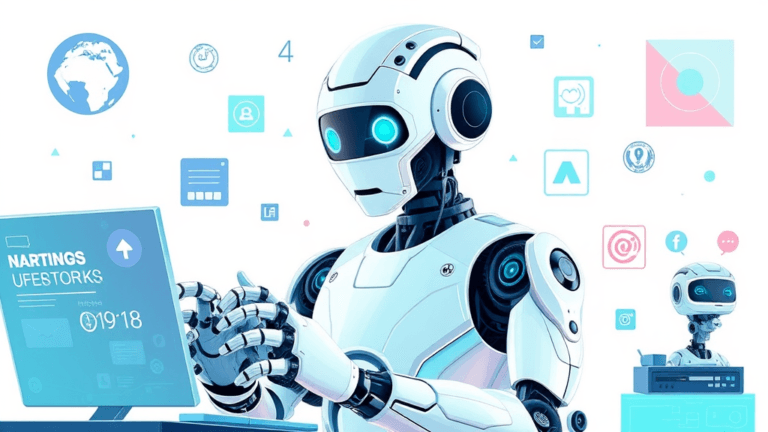
Virtual AI Assistant: Your Pocket-Sized Productivity Powerhouse
Estimated reading time: 11 minutes
Key Takeaways: Why Virtual AI Assistants Aren’t Going Anywhere
- Personal & Business Game-Changer: From scheduling playdates to optimizing supply chains.
- Tech is Accessible: No-code tools let anyone build assistants, not just coders.
- Customer Support Revolution: 24/7 service without hiring night shifts.
- Implementation Matters: Phased rollouts and training prevent mutiny.
- Evolution is Key: Regular updates turn good assistants into irreplaceable teammates.
Table of Contents
- What Is a Virtual AI Assistant?
- Types of Virtual AI Assistants: Personal Buddies vs. Business Brainiacs
- Features of the Best Virtual AI Assistants
- Top Virtual AI Assistant Software in 2025
- AI-Powered Chatbot vs. Virtual Assistant: What’s the Difference?
- Implementing a Virtual AI Assistant Without the Headaches
- Common Challenges (and How to Beat Them)
- The Future of Virtual AI Assistants
- How to Create a Virtual AI Assistant: From Concept to Code
- Virtual AI Assistant for Customer Support: The Silent Hero of Happy Clients
- AI-Powered Chatbot vs. Virtual Assistant: Choose Your Fighter
- Implementing a Virtual AI Assistant Without Chaos
- Key Takeaways: Why Virtual AI Assistants Aren’t Going Anywhere
- FAQs: Your Burning Questions, Answered
- Ready to Join the AI Revolution?
Remember when asking a machine to play your favorite song felt like science fiction? Today, virtual AI assistants handle everything from dimming your lights to managing corporate budgets. These digital sidekicks have evolved from quirky novelties to indispensable tools reshaping how we live and work. Let’s dive into what makes them tick, why they’re changing the game, and how to pick the perfect one for your needs.
What Is a Virtual AI Assistant?
A virtual AI assistant is like having a Swiss Army knife for your digital life. It’s a software tool powered by artificial intelligence (AI) that uses technologies like natural language processing (NLP) and machine learning to understand requests, complete tasks, and even predict your needs. Imagine telling your phone, “Schedule a meeting with Alex at 3 PM tomorrow,” and watching it handle the rest—no typos, no calendar juggling. That’s the magic of virtual AI assistant software in action 1 2. How Can AI Help Business
How Do They Differ From Traditional Tools?
Old-school virtual assistants (think early chatbots) followed rigid, pre-programmed scripts. If you strayed from their limited playbook, they’d respond with frustrating “I don’t understand” messages. Modern AI-powered virtual assistant apps, however, learn from interactions. They adapt to your speech patterns, preferences, and even your typos. For instance, if you often ask, “What’s on my plate today?” your assistant might start summarizing meetings and deadlines without being prompted 3. How AI Can Save Your Business Time And Money Through Automation
Here’s the kicker: these tools get smarter over time. The more you use them, the better they anticipate your needs. It’s like training a puppy—except this one never chews your shoes.
Types of Virtual AI Assistants: Personal Buddies vs. Business Brainiacs
AI Assistant for Personal Use
Your AI assistant for personal use is the ultimate life hack. Whether it’s Siri cracking jokes, Google Assistant sorting your commute, or Alexa settling dinner debates (“Hey, what’s the capital of Mongolia?”), these tools streamline daily chaos.
Key perks include:
- Automating routines: “Hey Google, start my morning” could trigger lights, news updates, and coffee brewing.
- Personalized nudges: Your assistant might remind you to leave early for a flight based on real-time traffic.
- Hands-free help: Cooking with messy hands? Ask Alexa to set a timer or read a recipe step aloud 4.
Ever had your assistant mishear “play relaxing jazz” as “play llama facts”? Yeah, they’re smart—but not perfect.
Virtual AI Assistant for Businesses
Businesses are deploying these tools like secret weapons. A virtual AI assistant for businesses can tackle tasks that once ate up hours:
- Scheduling: Automatically finding meeting times across time zones.
- Customer support: Answering FAQs instantly, 24/7.
For example, a retail company might use one to track inventory, notify staff about low stock, and even draft restock emails. The result? Employees focus on big-picture work instead of administrative shuffle Multi Agent Systems AI Integration. How AI Agents For Business Are Revolutionizing The Modern World
Features of the Best Virtual AI Assistants
What separates a mediocre assistant from a smart virtual assistant AI? Let’s break it down:
Core Capabilities
- Natural Language Processing (NLP): Understands slang, accents, and even sarcasm (well, mostly).
- Predictive smarts: Suggests tasks before you ask, like warning about a conflict in your calendar.
- Ironclad security: Encrypts data to keep sensitive info safe.
Must-Have Features
| Feature | Why It Matters |
|---|---|
| 24/7 Availability | No downtime—your assistant is always on. |
| Software Integration | Syncs with tools like Slack or Outlook. |
| Customizable Commands | Tailor actions to your workflow. |
A great assistant feels less like software and more like a diligent colleague.
Top Virtual AI Assistant Software in 2025
Navigating the sea of AI-powered virtual assistant apps can feel overwhelming. Here’s a cheat sheet:
Comparison of Leading Tools
| Software | Pros | Cons |
|---|---|---|
| Microsoft Copilot | Seamless with Office 365, great for teams | Pricey for small businesses |
| ChatGPT | Adapts to any industry, highly customizable | Requires tech know-how for setup |
| Google Assistant | Free tier, perfect for Android users | Limited advanced features |
| Superhuman | Lightning-fast email management | Focused solely on email, not other tasks |
Free AI virtual assistant options like Google Assistant or basic Alexa are fantastic for testing the waters. But for heavy lifting, paid tools offer deeper customization 6. How Can AI Help Business
AI-Powered Chatbot vs. Virtual Assistant: What’s the Difference?
Confused about chatbots and AI assistants? You’re not alone. Here’s a quick showdown:
| Feature | Chatbot | Virtual AI Assistant |
|---|---|---|
| Complexity | Handles simple Q&A | Manages multi-step tasks |
| Learning Ability | Stays static unless reprogrammed | Evolves with each interaction |
| Use Case | Answering “Where’s my order?” | Planning events, analyzing data |
While chatbots are great for FAQs, virtual assistant AI software tackles complex, personalized workflows.
Implementing a Virtual AI Assistant Without the Headaches
Step 1: Start Small
Roll out your assistant in phases. Maybe begin with automating meeting scheduling before tackling customer queries.
Step 2: Train Your Team (and Your Assistant)
Hold a lunch-and-learn session to ease adoption. Monitor interactions to refine your assistant’s responses.
Pro tip: Name your assistant! “ClunkyBot 3000” feels less approachable than “Sam.”
Step 3: Measure and Optimize
Track metrics like time saved or query resolution rates. Tweak your assistant’s scripts based on feedback. AI Customer Service Agent Revolution
Common Challenges (and How to Beat Them)
- “My team hates the new system”: Involve employees in the selection process—they’ll feel heard.
- Privacy concerns: Opt for assistants with GDPR or HIPAA compliance.
- Integration hiccups: Choose tools with APIs that play nice with your current software.
Remember, even the fanciest AI needs a human touch. Treat your assistant as a collaborator, not a replacement.
The Future of Virtual AI Assistants
As these tools gain emotional intelligence, expect assistants that detect stress in your voice and adjust their tone. Maybe they’ll even mediate office disputes (“I sense tension. How about a Zoom coffee break?”). For now, they’re content saving us hours and keeping our lives running smoothly—one automated task at a time.
How to Create a Virtual AI Assistant: From Concept to Code
Ever wondered how to build your own AI sidekick? Whether you’re automating your small business or creating the next Alexa, here’s your blueprint.
Step 1: Define Your Assistant’s Purpose
Start by asking: “What problem am I solving?” A how to create a virtual AI assistant project begins with laser-focused goals. Will it manage calendars, analyze data, or troubleshoot IT issues? For example, a bakery might build an assistant that tracks ingredient inventory and alerts staff when flour runs low.
Pro tip: Involve end-users early. Their pain points will shape your assistant’s priorities.
Step 2: Choose Your Tech Stack
Pick virtual assistant AI software tools that match your skill level:
- No-code platforms: Tools like Voiceflow or Landbot let you drag-and-drop workflows.
- Pro frameworks: OpenAI’s API or Google’s Dialogflow for custom NLP models.
- Cloud services: Microsoft Azure AI for enterprise-grade scalability.
| Platform | Best For | Learning Curve |
|---|---|---|
| OpenAI | Customizable conversations | High |
| Dialogflow | Voice & chat integrations | Medium |
| Amazon Lex | AWS ecosystem users | Moderate |
Need a shortcut? Customized AI Solutions Businesses offers pre-built templates to jumpstart development.
Step 3: Teach Your Assistant to Listen
Integrate natural language processing (NLP) so your tool understands slang, typos, and accents. Tools like Hugging Face’s Transformers library can process phrases like “Resched my 3 PM with Karen” into calendar updates.
Don’t forget speech-to-text engines! Whisper AI (open-source) or Google’s Speech-to-Text API turn “Um, can you… never mind” into actionable commands.
Step 4: Design for Real Humans
A smart virtual assistant AI needs intuitive interfaces. Options include:
- Voice-first: Ideal for hands-free kitchens or drivers.
- Text-based: Perfect for detail-oriented tasks like data entry.
- Hybrid: Combines voice commands with visual dashboards.
Test accessibility: Can users with screen readers or motor impairments navigate it?
Step 5: Launch, Learn, Repeat
Deploy a beta version to a small group. Track metrics like:
- Task completion rate
- User satisfaction (hint: emoji ratings work wonders)
- Error frequency
Update your assistant weekly. One logistics company reduced scheduling errors by 62% after refining its NLP model based on driver feedback.
Virtual AI Assistant for Customer Support: The Silent Hero of Happy Clients
Picture this: A customer messages your help desk at 2 AM about a broken product. Instead of waiting 8 hours, your virtual AI assistant for customer support troubleshoots the issue instantly—no caffeine required.
Why AI Support Agents Win
- 24/7 Availability: They don’t sleep, take vacations, or miss calls.
- Scale Without Hiring: Handle 1,000+ queries simultaneously.
- Consistency: No more “Karen got a different answer from Dave.”
Case in point: A telehealth startup reduced appointment no-shows by 35% using an assistant that sends SMS reminders and reschedules via text.
Building a Support Superstar
Key features to include:
- Ticket Routing: Classify urgent vs. routine requests.
- Sentiment Analysis: Detect frustration in messages like “This is the THIRD time I’ve called!!” and escalate to humans.
- Self-Service Portals: Let users track orders or reset passwords autonomously.
“AI assistants cut our average response time from 12 hours to 3 minutes.” – E-commerce CEO (Rezolve AI Blog)
AI-Powered Chatbot vs. Virtual Assistant: Choose Your Fighter
Still torn between a chatbot and an AI assistant? Let’s settle this like a tech version of Rocky vs. Drago.
Round 1: Functionality
- Chatbots: Great for scripted scenarios like password resets.
- Virtual Assistants: Excel at complex tasks—imagine one that compares insurance plans based on your medical history.
Round 2: Adaptability
Chatbots follow rules. Virtual assistants learn from them. For example, if users keep asking “What’s the return policy?” after buying shoes, a smart assistant might proactively add policy links to order confirmations.
When to Use Which
| Scenario | Best Tool |
|---|---|
| Answering “Store hours?” | Chatbot |
| Managing multi-step IT tickets | Virtual AI Assistant |
| Personalized shopping advice | Virtual AI Assistant |
Pro tip: Combine both! Use a chatbot for FAQs and route complex issues to your assistant.
Implementing a Virtual AI Assistant Without Chaos
Rolling out AI tools can feel like herding cats. Here’s how to avoid the hair-pulling phase.
Phase 1: Pilot with Power Users
Start with a team that’s tech-savvy and patient. For example, deploy a virtual AI assistant for businesses in your accounting department to automate invoice processing. AI Virtual Assistant Phone Support Track time saved and error rates.
Phase 2: Integrate with Existing Tools
Ensure your assistant plays nice with:
- Communication apps (Slack, Teams)
- CRM systems (Salesforce, HubSpot)
- Cloud storage (Google Drive, Dropbox)
APIs are your friend here. One marketing agency linked their assistant to Asana, cutting meeting time by 20%.
Phase 3: Train Like You’re Explaining TikTok to Your Grandma
- Create bite-sized tutorial videos
- Host “AI Office Hours” for troubleshooting
- Share success stories: “Meet Sarah, who saved 6 hours/week using the assistant!”
FAQs: Your Burning Questions, Answered
1. Can I get a free AI virtual assistant?
Yes! Google Assistant and basic Alexa are free. For businesses, tools like Landbot offer freemium models.
2. What’s the biggest mistake when implementing AI assistants?
Skipping user testing. One company’s assistant kept mishearing “archive” as “arrest”—awkward.
3. How secure are virtual AI assistants?
Reputable tools use encryption and compliance certifications. Always check for GDPR or HIPAA compliance.
4. Can assistants handle non-English languages?
Most major tools support Spanish, Mandarin, etc. However, accuracy varies—test thoroughly.
5. What’s the average setup time?
Simple chatbots: 2-3 days. Custom AI assistants: 2-6 months.
6. Do they work offline?
Most require internet, but some (like Apple’s Siri) handle basic tasks offline.
7. How do I measure ROI?
Track time saved, error reduction, and customer satisfaction scores pre/post-launch.
Ready to Join the AI Revolution?
Virtual AI assistants aren’t the future—they’re the now. Whether you’re streamlining operations or crafting a five-star customer experience, the right tool can turn chaos into calm.
Your Next Move:
Got questions? Drop them below or share your favorite AI assistant hack! 👇






